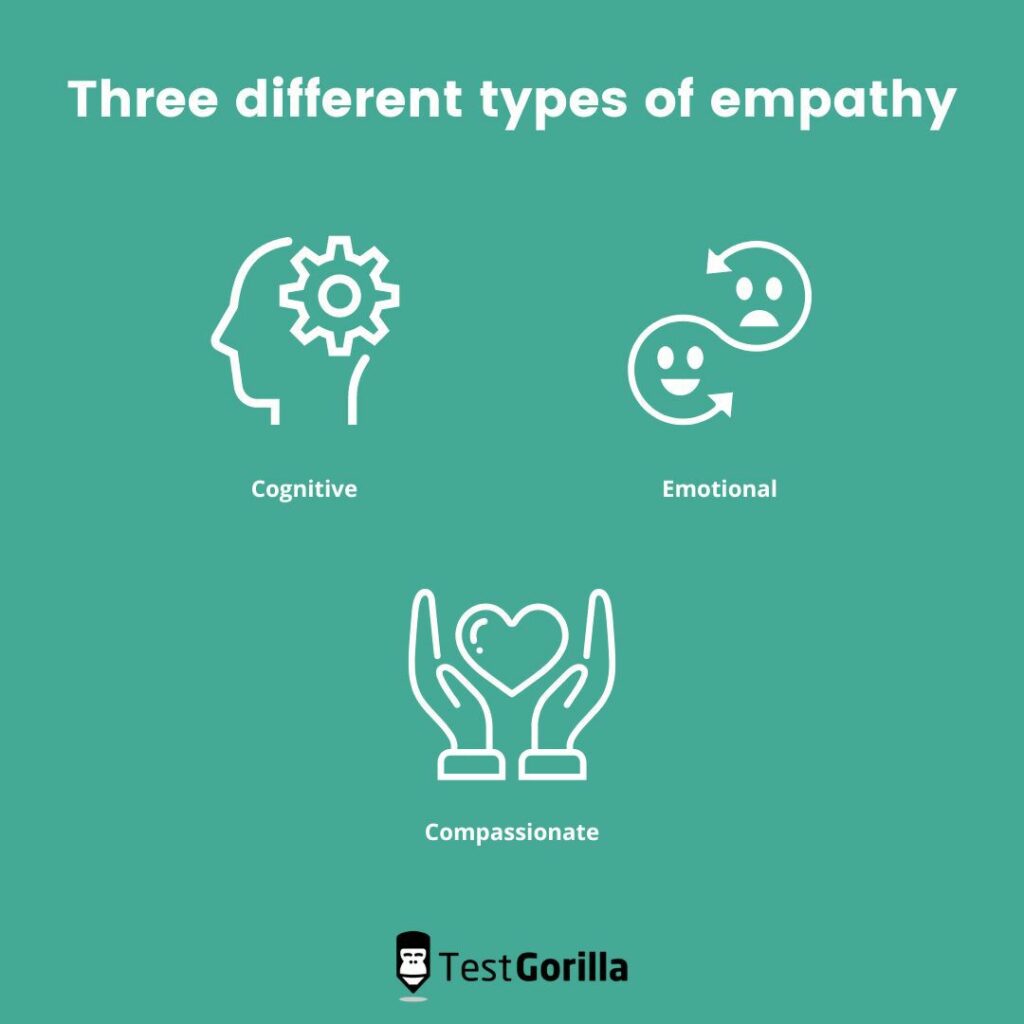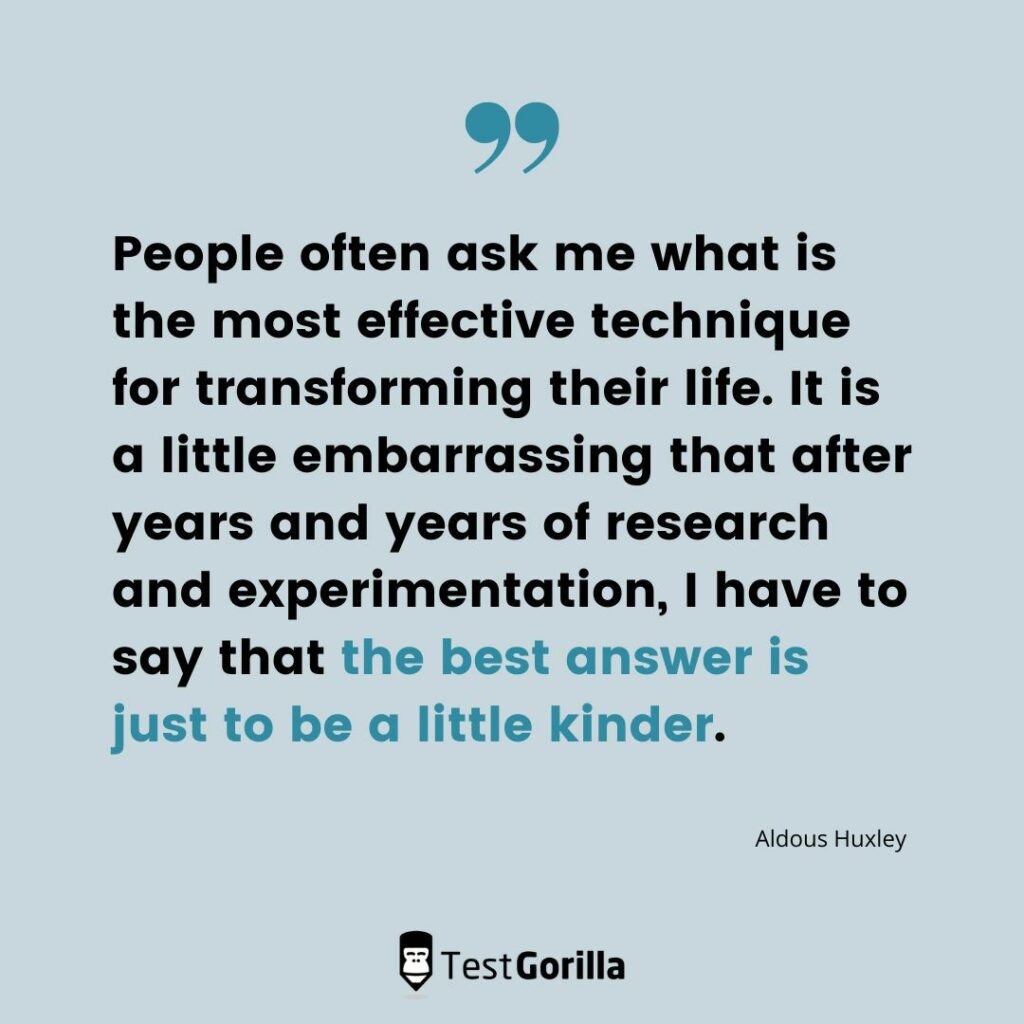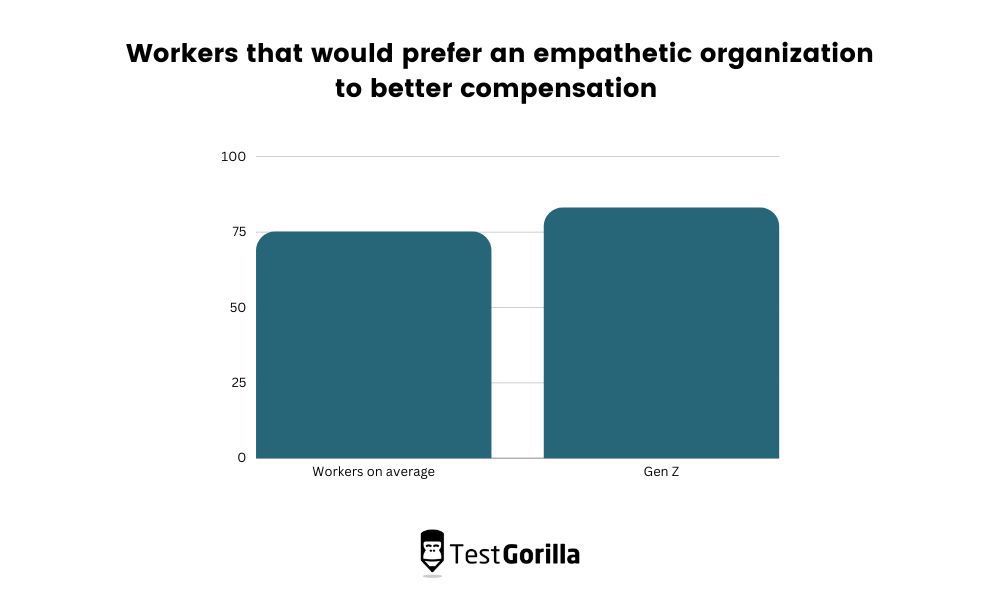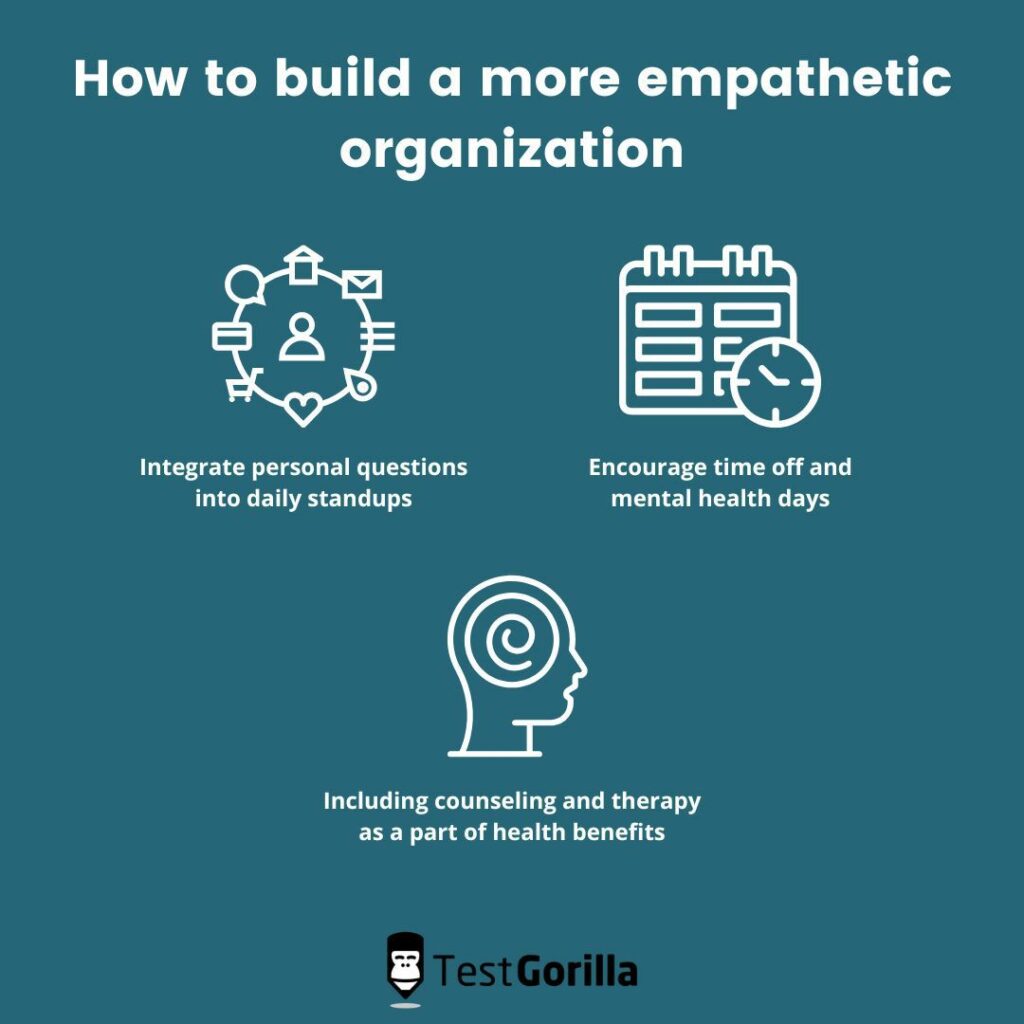Genuine empathy in the workplace matters.
It helps you foster a positive environment, communicate more effectively, and solve problems.
Empathy also promotes an inclusive workplace so that your employees actually want to come to work and be themselves.
This leads to many positive outcomes, such as improved business performance, reduced employee burnout, and stronger employee trust.
That’s why it’s unfortunate that 60% of chief executives believe their organizations are empathetic, although only 24% of their employees agree.[1]
Filling this gap is key, and we believe companies can change this imbalance, improving inclusivity and empathy in business and becoming places where employees want to work.
This article explores examples of empathy in the workplace. It also explains the benefits of empathy to your organization and the top seven strategies you can adopt to encourage a culture of empathy.
Table of contents
What is empathy in the workplace?
Empathy is the ability to understand the emotions of others. This ranges from simply being aware of someone’s feelings to putting yourself in their place and seeing things from their point of view.
Empathizing with others can be complex and challenging, but it’s essential for a well-functioning workplace.
There are three main types of empathy a person can display:
Cognitive: knowing, understanding, and comprehending another person’s feelings
Emotional: directly feeling the emotion that the other person is feeling
Compassionate: acting on emotional and cognitive empathy to care for the person
Let’s see the difference between these types of empathy by drawing on a scenario.
Muhammed is working on a project that he’s pouring his heart into, but the client has dropped funding for it, and the whole thing is canceled.
Here are examples that represent the three types of empathetic responses in the workplace:
Cognitive empathy: “I know this project meant a lot to you. You must be feeling really disappointed.”
Emotional empathy: “I feel disappointed, too, because I know how much that meant to you.”
Compassionate empathy: “You must feel really disappointed. I feel for you. Is there any way I can help you?”
Before we move on, we need to quickly cover the difference between empathy and sympathy since the two concepts are often confused.
Empathy is understanding someone’s emotions. Sympathy is acknowledging someone’s emotions, but it doesn’t involve shared perspectives as empathy does.
When you experience sympathy, you feel bad for a person but don’t fully understand what they’re going through. This could be by choice or because you can’t fully comprehend what that person is experiencing on an emotional level.
Now, let’s cover some practical examples of empathy in the workplace.
Examples of empathy in the workplace
It’s all well and good to tell you about the importance of empathy. But to help you understand why it makes such a powerful impact, let’s describe a few scenarios in which employees take an empathetic approach.
Here are some excellent examples of empathy in the workplace and their positive outcomes:
Maria was disparaged and talked over during her presentation. Her co-worker, Jaya, tells her she has a right to be upset and asks if she’d like to take a lunch break together.
Outcome: Maria had support in a time of need, reducing her stress, increasing her performance, and possibly preventing her from quitting.
Sean offers a different point of view from Grace’s during a brainstorming session. They both respectfully listen and vocally acknowledge each other’s different perspectives, although their own opinions stay the same.
Outcome: Both opinions are respected, and the brainstorming session doesn’t turn into conflict.
Yuri, a middle manager, genuinely listens to employee feedback and incorporates it into the company’s processes as best she can.
Outcome: Employees are felt, heard, and respected, increasing work quality, retention, and engagement.
After the distress that came in 2020, including the anxiety and stress caused by the Covid-19 pandemic and unfortunate amounts of social and racial unrest, Zendesk implemented “Empathy Circles” as a practice in the company.
These video meetings involve picking a central topic, such as mental health, political injustice, or microaggressions, and encouraging honest conversation, real empathy, and an understanding of different opinions.
Another great example of empathy (albeit one that exceeds most workers’ capabilities) comes from Marc Benioff, the chief executive of Salesforce.
Kristin Auger, a strategic account executive, recounts the story of when Benioff offered to fly her four-year-old son to San Francisco for open-heart surgery.
This gesture aligned with Benioff’s beliefs that if your employees don’t feel supported and safe, you won’t have the strong organization you want.
Building a solid business relies on compassionate, empathetic people. Empathy drives performance, retention, and co-operation and makes your company one that people want to work for.
We think this quote by Aldous Huxley says it well:
With that said, let’s discuss the benefits of empathy in the workplace in detail.
The benefits of empathy in the workplace
Understanding and supporting your people through empathy has far-reaching benefits.
It builds a stronger company culture, boosts teamwork, and creates an encouraging, safe space for employees to do their best.
Let’s look at a few of the benefits of workplace empathy:
Benefit | Description |
Better performance | When an employee is heard and understood, it greatly impacts their performance and the quality of their work |
Better leaders | Empathetic leaders are able to read emotions and situations more easily, enabling them to lead more effectively |
Better cross-cultural communication and management | Actively making an effort to empathize with another person’s perspective boosts cultural communication and understanding |
Stronger connections and relationships | Support and understanding lead to stronger work connections and more |
Improved team morale | Feeling heard and understood improves team dynamics, relationships, and enthusiasm |
Helps mitigate issues like employee burnout | Empathy helps workers develop a stronger connection with their company so that they don’t feel detached and unrecognized, which is a leading cause of employee burnout |
Boosts customer service | Encouraging empathy helps workers understand clients’ and customers’ feelings better |
Helps to curb and eliminate toxic workplace behaviors | Promoting a culture of empathy and positivity naturally reduces toxic behaviors in your workplace |
Empathy in the workplace can also be a powerful hiring advantage.
One study showed that 75% of workers on average and 83% of Gen Z would take an organization with a strong atmosphere of empathy over better compensation.
This shows that a positive, empathetic culture is particularly effective when hiring Gen Z.
Aside from the tangible business benefits that make a company better and easier to work for, having a strong culture of empathy is simply the right thing to do.
A recent study showed that 45% of employees have cried at work.[2] This is a regrettable number of people, but beyond that, the fact that a study like this had to be conducted in the first place shows something about typical work conditions.
But we can change that. Together, we can build stronger, more empathetic workplaces.
How to build a more empathetic organization
Now we’ll go over the top strategies you can implement to encourage organizational empathy.
Here’s a quick summary of the best practices:
Strategy | Description |
1. Integrate empathy and teamwork into your organizational culture | Build empathy into your company culture, and it will become second nature |
2. Have your senior leadership lead by example | Lead from the top by having senior leadership display empathy |
3. Hire people high in empathy and compassion | Use skills testing to hire empathetic, compassionate employees |
4. Reward empathetic behavior and reduce antisocial tendencies | Praise empathy and teamwork publicly to reinforce their place in your company |
5. Encourage team building and development to create more meaningful connections | Nurture team relationships and build trust with your employees with communication and transparency |
6. Facilitate conversations and open-door policies | Make employees feel safe and welcome to open up and talk |
7. Commit to being an accepting, inclusive workplace | Foster employee connection and trust by standing by a culture of inclusivity |
Now, let’s talk about these seven strategies in depth.
Integrate empathy and teamwork into your organizational culture
Build your organizational culture on a foundation of empathy and positivity.
This means fostering an atmosphere where employees are treated like human beings rather than resources. They aren’t just assets to accomplish a goal – they’re people with goals, personal issues, and lives.
There are many ways to practice empathy in your company culture:
Integrate personal questions into daily standups: Questions about your workers’ families, hobbies, and milestones go a long way in displaying empathy
Encourage time off and mental health days: When your business shows that it cares about more than just physical ailments and recognizes mental health, it makes people feel cared for and understood
Including counseling and therapy as a part of health benefits: Offering employees therapy, counseling, and coaching gives them much-needed support
You can further weave empathy into your company’s culture and core values by publicly showing that your organization cares about social responsibility and empathetic values.
Corporate social responsibility helps your business be accountable to itself, its stakeholders, and the public. Practicing this type of empathetic responsibility is not only the right thing to do but also displays your brand as an ideal workplace for potential candidates.
Potential hires and current employees alike benefit from a caring company culture. This is why culture has been cited as one of the top job satisfaction factors, alongside solid senior leadership.
This leads us to our next best practice.
Have your senior leadership lead by example
Employees practice what their leaders teach – that’s why companies have leaders.
No matter what you’re telling your workers, at the end of the day, they’re most likely to do as you do, not as you say.
That’s why it’s crucial to have empathetic leadership in the workplace. A good place to start is to teach your managers active listening skills, like the following.
Listening to the meaning behind words, not just focusing on the words themselves
Reflecting information by paraphrasing (e.g., “What I’m hearing you say is…”)
Clarifying unclear statements instead of making assumptions
Being an active participant and relating where possible
The last point is easiest to follow when leaders are encouraged to share challenges and failures with colleagues.
It isn’t always easy to do, but leaders expressing their struggles, how they felt during them, and how they were affected by them (whether positively or negatively) has a huge impact on your employees’ overall perception of empathy.
Another way to lead from the top is by practicing nonviolent communication during workplace conflict. A patient and unbiased mediator displays your organization’s belief in empathy and positivity.
Hire people high in empathy and compassion
Ensure your workforce continues a trend of empathy by hiring compassionate employees.
An excellent way to make sure candidates display the emotional understanding your business needs is to implement online skills testing in your pre-employment assessments.
Here are a few TestGorilla tests that will help you assess a candidate’s empathy and compassion:
The Big 5 Personality test assesses a candidate’s openness, conscientiousness, extroversion, agreeableness, and emotional stability
The Enneagram test maps out a candidate’s core beliefs, worldview, approach to conflict resolution, and team dynamics
The Culture Add test determines how a candidate’s values and behaviors align with your company culture
Once you’ve established a firm company culture rooted in empathy and compassion, you can use the Culture Add test to assess whether or not the candidate would make a good addition to your business (for example, if they have solid empathy).
You can also use skills testing on existing employees to assess which workers lack your company’s values. Then, you can coach and mentor those individuals during 1:1 meetings.
Remember, empathy is a learnable skill.
Another way to hire empathetic employees is to integrate structured interviews into your hiring process.
In a structured interview, the interviewer has a set of premade questions that focus on core competencies and behavioral and situational questions.
For more on this topic, read our in-depth guide on unstructured versus structured interviews.
Reward empathetic behavior and reduce antisocial tendencies
Uplifting and celebrating shows of employee empathy are excellent ways to encourage this behavior.
Try rewarding great shows of empathy and teamwork by pointing them out during daily standups, team huddles, or in a group chat channel like Slack or Google Chat.
Make it clear that empathy, teamwork, and good people skills are an expectation in your organization and that you don’t tolerate poor workplace behavior.
If a team member doesn’t fulfill these expectations, you can coach and create a progression plan for them.
Of course, it’s important to be realistic and understand that not every job role requires high empathy.
Good social skills and empathy are critical for roles like HR managers and project leaders. However, they aren’t imperative soft skills for accountants and software engineers.
This doesn’t mean these people shouldn’t be held accountable for poor behavior but rather that empathetic social skills may not be required for them to succeed in their role.
Encourage team building and development to create more meaningful connections
Encouraging meaningful relationships and co-operation helps build natural empathy in your work environment.
Relationships can’t be forced, and people can only practice a certain level of empathy. However, empathetic interactions become much more natural the more closely connected your team is.
Team building is especially important in remote and hybrid teams in which relationships aren’t created naturally. It’s much harder to meaningfully nurture working relationships when the team is separated in their own home offices. But it’s definitely possible!
A great way to nurture team development is to create a flatter, more transparent organization where employees are involved in decision-making. This instills feelings of value and trust and develops a greater sense of camaraderie.
Here are a few ways to better involve your employees:
Talk to them and ask their opinions
Conduct employee surveys
Give them kudos when their idea is used or noticed by clients
Request their input on business decisions
Involving employees in decision-making is a critical part of change management and essential for a trauma-informed workplace.
Facilitate conversations and open-door policies
Empathy in the workplace flourishes when employees feel safe enough to open up.
You can facilitate healthy conversations by proactively encouraging them. Check in with employees, ask them how they’re doing, and let them know they can come to you if they need to talk.
Set aside a few minutes during 1:1 meetings to talk about mental health, personal life struggles, and any grievances employees may have.
Ensure your business displays open-door policies, too. Discouraging communication is counterproductive when implementing an empathetic culture.
Taha Elraaid, the chief executive officer of Lamah Technologies, says he encourages all employees, including team managers and chief executives, to make their email addresses and phone numbers available to all workers.
Taha believes this is an effective way to show, not tell, your colleagues that you’re open and ready to talk.
Commit to being an accepting, inclusive workplace
Accepting your employees for who they are builds positivity, empathy, and compassion between workers.
There’s a distinct difference between upholding workplace standards and making a worker feel inferior for being themselves.
For example, an employee with ADHD might require instructions or rules to be written down instead of spoken to account for their auditory processing difficulties.
This isn’t a shortcoming – it’s a difference in how they process information. Respecting such differences is key to fostering a culture of empathy.
Embracing each employee’s unique self instills a sense of belonging, which reinforces a feeling of trust and safety.
Inclusivity automatically creates a base layer of empathy for your workplace. It helps you understand others’ differences, even if you don’t walk the same path.
Start nurturing empathy in the workplace
Empathy in business is a powerful tool.
It improves job performance, reduces turnover, and builds strong connections between employees.
Foster empathy in your company culture by encouraging communication, rewarding acts of empathy, and leading from the top with empathetic managers.
For more information on promoting a culture of empathy in your organization, read our article on peer-to-peer recognition.
To assess your next candidate’s compassion and social skills, use our Leadership & People Management test in your pre-employment assessment.
Sources
“State of Workplace Empathy”. (2022). Businessolver. Retrieved November 3, 2022. https://www.businessolver.com/resources/state-of-workplace-empathy
“Cry Me A River: How Emotions Are Perceived In The Workplace”. (April 3, 2018). Robert Half. Retrieved November 3, 2022. https://press.roberthalf.com/2018-04-03-Cry-Me-A-River-How-Emotions-Are-Perceived-In-The-Workplace
Related posts
Hire the best candidates with TestGorilla
Create pre-employment assessments in minutes to screen candidates, save time, and hire the best talent.
Latest posts
The best advice in pre-employment testing, in your inbox.
No spam. Unsubscribe at any time.

Hire the best. No bias. No stress.
Our screening tests identify the best candidates and make your hiring decisions faster, easier, and bias-free.
Free resources
This checklist covers key features you should look for when choosing a skills testing platform
This resource will help you develop an onboarding checklist for new hires.
How to assess your candidates' attention to detail.
Learn how to get human resources certified through HRCI or SHRM.
Learn how you can improve the level of talent at your company.
Learn how CapitalT reduced hiring bias with online skills assessments.
Learn how to make the resume process more efficient and more effective.
Improve your hiring strategy with these 7 critical recruitment metrics.
Learn how Sukhi decreased time spent reviewing resumes by 83%!
Hire more efficiently with these hacks that 99% of recruiters aren't using.
Make a business case for diversity and inclusion initiatives with this data.
























